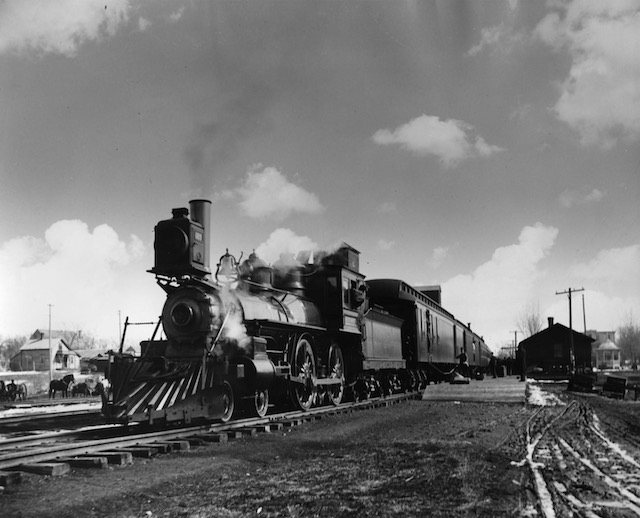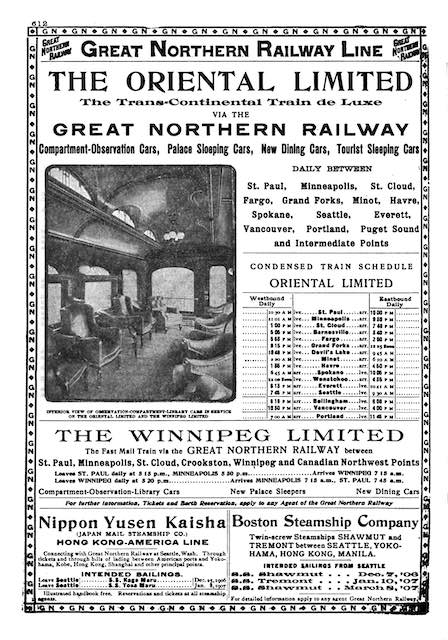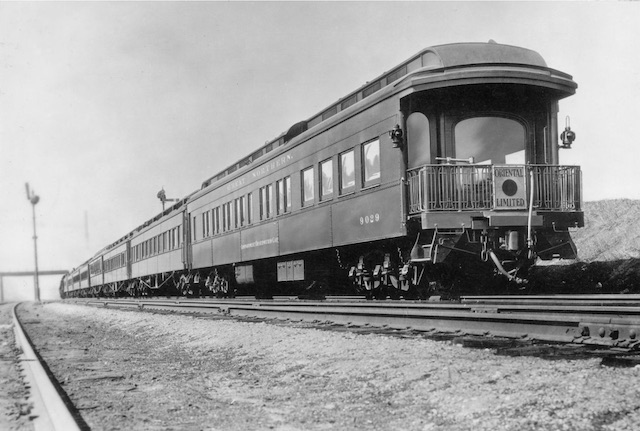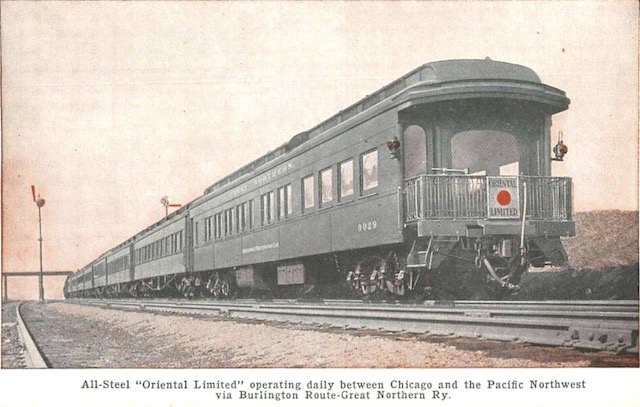The Great Northern punched its line through the Cascade Mountains to Seattle in January 1893, almost a decade after Northern Pacific and eight years after Union Pacific reached Portland. While NP didn’t name any of its trains or offer a limited train until 1900, Great Northern went through a series of names before finally settling on the evocative Oriental Limited in 1905.

Stopping for passengers in Cokato, Minnesota in about 1900, the Great Northern Flyer is led by a diminutive 4-4-0 American locomotive that produced only about 13,100 pounds of tractive effort. Bigger, 4-6-0, locomotives would be used in the mountains. Click image for a larger view.
GN’s first St. Paul-Seattle trains began operating on June 18, 1893. They were numbered 3 & 4 (1 & 2 only went as far as Grand Forks) and didn’t have a name. The 1893 timetables called them the “Washington Line,” but this referred more to the route as opposed to the “Montana Line” which served Great Falls, Helena, and Butte. East of Pacific Junction, Montana (right outside of Havre), both “lines” were the same train.
West of Pacific Junction, both trains included Palace sleeping cars, “free [meaning no sleeping car fares] colonist cars,” coaches, and food service cars. These cars were painted maroon with gold lettering; the use of “Pullman green” did not become ubiquitous until after 1900.
The colonist cars to Seattle had platforms for sleeping but no beds or linens. The Seattle train also included tourist sleepers three days a week. Most of the sleeping cars were built by Barney & Smith, not Pullman, and for many years Great Northern operated its own sleepers rather than let Pullman handle them, as most railroads did. One sleeping car on the Seattle train went through to or from Chicago over the Chicago, Milwaukee & St. Paul road.
Great Northern’s route from St. Paul to Seattle was almost 100 miles shorter than NP’s route from St. Paul to Tacoma. While NP’s train to Tacoma took 81 hours, GN’s train #3 took 77-3/4 hours to travel the 1,827 miles from St. Paul to Seattle, an average of 23.5 mph, making more than 200 stops along the way.
On May 5, 1895, Great Northern jumped on the limited bandwagon by naming trains 3 & 4, unoriginally, the Limited. The main enhancement was the addition of library-buffet cars. Deleting about a third of the stops reduced the St. Paul-Seattle time to about 68 hours. Great Northern also sent sleepers and coaches to Portland over the Oregon Railroad & Navigation Company. In 1898, the Limited‘s library-buffet cars were replaced with library-observation cars.
Perhaps recognizing that the Limited wasn’t a very distinctive name, on January 2, 1899, Great Northern renamed its St. Paul-Seattle train the Great Northern Flyer. Still numbered 3 & 4, the train made about the same number of stops as the Limited, but GN managed to reduce the time for the westbound train to 62 hours; eastbound took 64 hours. The railway also began painting its cars dark green rather than maroon. This train is probably what led the Northern Pacific to introduce the North Coast Limited.
In 1903, demand had increased sufficiently that Great Northern added a second St. Paul-Seattle train. This was numbered 3 & 4 while the Flyer was renumbered 1 & 2. Trains 3 & 4 were initially called the Puget Sound Express westbound and Eastern Express eastbound. In 1906, trains 3 & 4 became the Fast Mail; then, in 1910, the Oregonian; and in 1915, the Glacier Park Limited, which name they kept until the 1929 introduction of the Empire Builder.
 This ad in the December, 1906, Official Guide, called the Oriental Limited the “Trans-Continental Train de Luxe.” This is one of the rare uses of “de luxe” in passenger train advertising before Santa Fe introduced its de Luxe in 1911. Click image for a larger view.
This ad in the December, 1906, Official Guide, called the Oriental Limited the “Trans-Continental Train de Luxe.” This is one of the rare uses of “de luxe” in passenger train advertising before Santa Fe introduced its de Luxe in 1911. Click image for a larger view.
In the meantime, Great Northern finally selected a truly evocative name for its premiere train in 1905, when it renamed the Flyer the Oriental Limited. There may have been some debate about the name within the company, as Railway Age reported on October 13, 1905, that the train would be called the Great Northern Limited and would “not be called the ‘Oriental Limited,’ as recently stated in newspaper reports.” However, when the train was inaugurated on December 5, it was called the Oriental Limited after all.

The observation car of the 1905 Oriental Limited had a large, plate-glass window in the back. Click image for a larger view.
Although the train kept numbers 1 & 2, the coaches, diners, and compartment-observation cars were all new, while the tourist and palace sleepers would be replaced with new equipment in 1907 or 1908. The observation cars included four compartments, a small “buffet” kitchen for snacks and drinks, a smoking room with about 13 seats, and an observation parlor with 15 seats. The observation parlor featured double-wide windows on each side and a huge plate-glass window in the rear to allow people to view with scenery without braving the wind and weather on the large rear platform.
The Oriental Limited was able to travel from St. Paul to Seattle in less than 60 hours (almost 31 mph), mainly by making only about 50 stops en route. It also used more powerful locomotives, as Great Northern had purchased its first 4-6-2 Pacific-type locomotives in 1905. These produced almost 29,000 pounds of tractive effort, and in 1906 GN bought even more powerful Pacifics that produced more than 37,500 pounds of tractive effort. When these were superheated in 1913, tractive effort went up to nearly 43,000 pounds.
Union Pacific had gained control of the Oregon Railroad and Navigation Company in 1898, but GN was still able to send cars to Portland over the latter railroad. However, after Edward Harriman lost the battle for control of the Northern Pacific, he spitefully ended GN’s Columbia River access to Portland (it could still reach Portland via Seattle). This led the GN and NP to build the Spokane, Portland and Seattle, but between 1906 and 1910, when the SP&S was completed, the Oriented Limited did not have a Portland section.
In 1911, the St. Paul Road reached Seattle and inaugurated two all-steel passenger trains between Chicago and Seattle: the Olympian and the Columbian. This led the Great Northern to improve the Oriental Limited. First, it replaced the existing wooden coaches with new all-steel coaches. Second, it put steel sheathing on the outside of the sleeping cars and other cars on the train. Finally, it coordinated with its semi-subsidiary, the Burlington Route, to extend Oriental Limited service to Chicago.

This postcard erroneously claims that the Oriental Limited shown, which is clearly the same picture as the previous photo, was “all steel.” When it finally did become an all-steel train in 1924, the door to the rear platform was in the center, not on one side. Click image to download a 155-KB PDF of the postcard.
The above postcard mentions the Burlington, showing it was issued after these changes were made. Although the back of the card says “En Route Via Great Northern,” it doesn’t use the Great Northern logo that is found on the railroad’s own postcards of that era, so it must have been issued by someone else who was confused about the difference between “all steel” and steel sheathing.
In 1922, Great Northern more honestly advertised the Oriental Limited as a “steel train,” with a picture clearly showing the same observation car. Without the all-important word “all” as in “all-steel,” describing a train as “steel” usually meant at least some of the cars had steel sheathing over wood.
